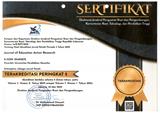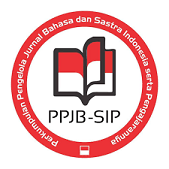PENGGUNAAN DEIKSIS DALAM NASKAH PIDATO SISWA KELAS X SMA NEGERI 2 BANJAR
DOI:
https://doi.org/10.23887/jjpbs.v3i1.5782Abstract
Penelitian ini bertujuan untuk (1) mendeskripsikan bentuk deiksis yang digunakan siswa dalam menulis naskah pidato siswa kelas X SMA Negeri 2 Banjar, (2) mendeskripsikan jenis-jenis deiksis yang digunakan dalam menulis naskah pidato siswa kelas X SMA Negeri 2 Banjar, (3) mendeskripsikan jenis acuan berdasarkan letak anteseden dari masing-masing jenis deiksis yang digunakan dalam menulis naskah pidato siswa kelas X SMA Negeri 2 Banjar. Dalam mencapai tujuan ini, peneliti menggunakan rancangan deskriptif-kualitatif. Subjek penelitian ini adalah siswa kelas X, yang mana siswa kelas X.3 sebagai sampelnya. Objek penelitian ini berupa deiksis yang terdapat dalam naskah pidato yang dibuat siswa kelas X.3 SMA Negeri 2 Banjar. Pengumpulan data menggunakan metode tes. Dari tes yang dilakukan siswa menghasilkan naskah pidato. Data yang diperoleh dianalisis dengan metode deskriptif-kualitatif yang meliputi tiga tahap, yaitu Reduksi data, penyajian data, dan penyimpulan. Hasil analisis menunjukkan bentuk deiksis yang digunakan siswa dalam menulis naskah pidato cukup beragam. Jenis-jenis deiksis yang siswa gunakan dalam menulis naskah pidato meliputi, (a) deiksis persona, (b) deiksis tempat, (c) deiksis waktu, (d) deiksis wacana, dan (e) deiksis sosial. Dilihat dari letak antesedennya, siswa menggunakan deiksis yang bersifat anafora dan katafora. Bentuk deiksis yang siswa gunakan memenuhi tiga bentuk, sedangkan jenis deiksis dari enam jenis deiksis yang ada hanya terpenuhi lima jenis saja. Dan dari jenis acuan yang digunakan sudah memenuhi teori yang ada. Dengan hasil ini siswa hendaknya memperhatikan penggunaan deiksis dalam menulis pidato karena dapat memengaruhi kekohesifan isi pidato. Kata kunci: deiksis, acuan, pidato,Kata Kunci : deiksis, acuan, pidato,
This study aims to (1) describe the form dexis used by students in writing the speech class X SMA Negeri 2 Banjar, (2) describes the types dexis used in writing the speech class X SMA Negeri 2 Banjar, (3) describe the type of reference based on the location of the antecedents of each type dexis used in writing the speech class X SMA Negeri 2 Banjar. In achieving this goal, researchers used a qualitative descriptive design. The subjects were students of class X, which X.3 grade students as a sample. The object of this research is deiksis contained in speeches that made the students. Collecting data using the test method. From tests conducted students produce speech. Data obtained analysis with qualitative descriptive method which includes three phases, namely data reduction, data presentation, and inference. The analysis showed that students use dexis form in writing speeches are quite varied. Types dexis that students use in writing the speech, there are five types of dexis, namely persona dexis, place dexis, time dexis, discourse dexis, and social dexis. Judging from the layout antecedent, students using dexis that is anaphora and kataphora. Dexis form that students are using meets three forms, while the type dexis of six types dexis that there are only five species are fulfilled. And of the type of reference that meets existing theories. With this result the students should pay attention to the use of dexis in writing because it can affect the cohesiveness speech content of the speech.
keyword : dexis, reference, speech,
Published
2015-08-03
Issue
Section
Articles
License
Authors who publish with the Jurnal Pendidikan Bahasa dan Sastra Indonesia Undiksha agree to the following terms:- Authors retain copyright and grant the journal the right of first publication with the work simultaneously licensed under a Creative Commons Attribution License (CC BY-SA 4.0) that allows others to share the work with an acknowledgment of the work's authorship and initial publication in this journal
- Authors are able to enter into separate, additional contractual arrangements for the non-exclusive distribution of the journal's published version of the work (e.g., post it to an institutional repository or publish it in a book), with an acknowledgment of its initial publication in this journal.
- Authors are permitted and encouraged to post their work online (e.g., in institutional repositories or on their website) prior to and during the submission process, as it can lead to productive exchanges, as well as earlier and greater citation of published work. (See The Effect of Open Access)







